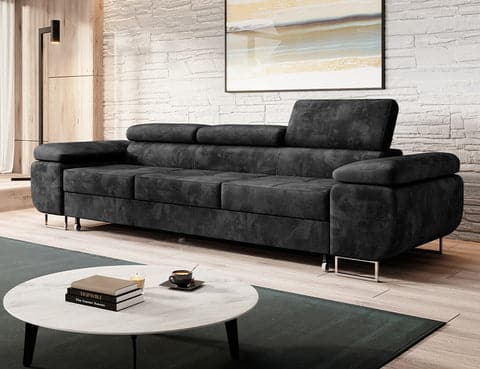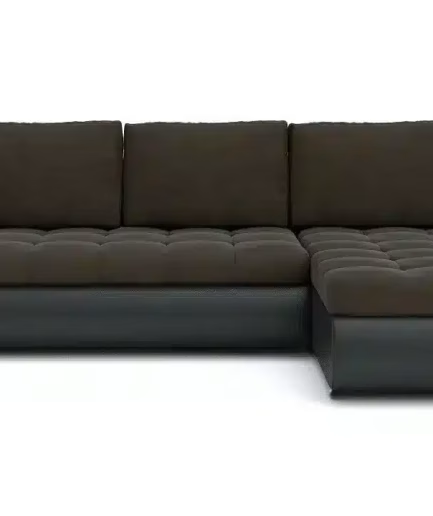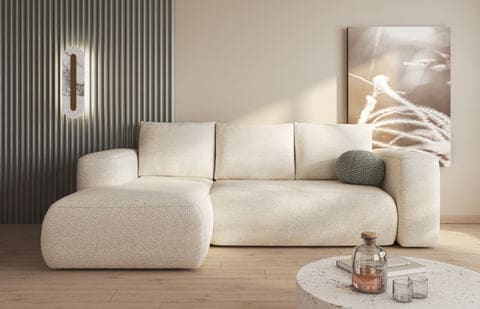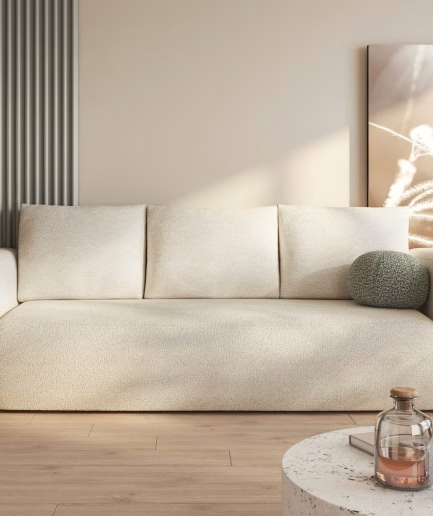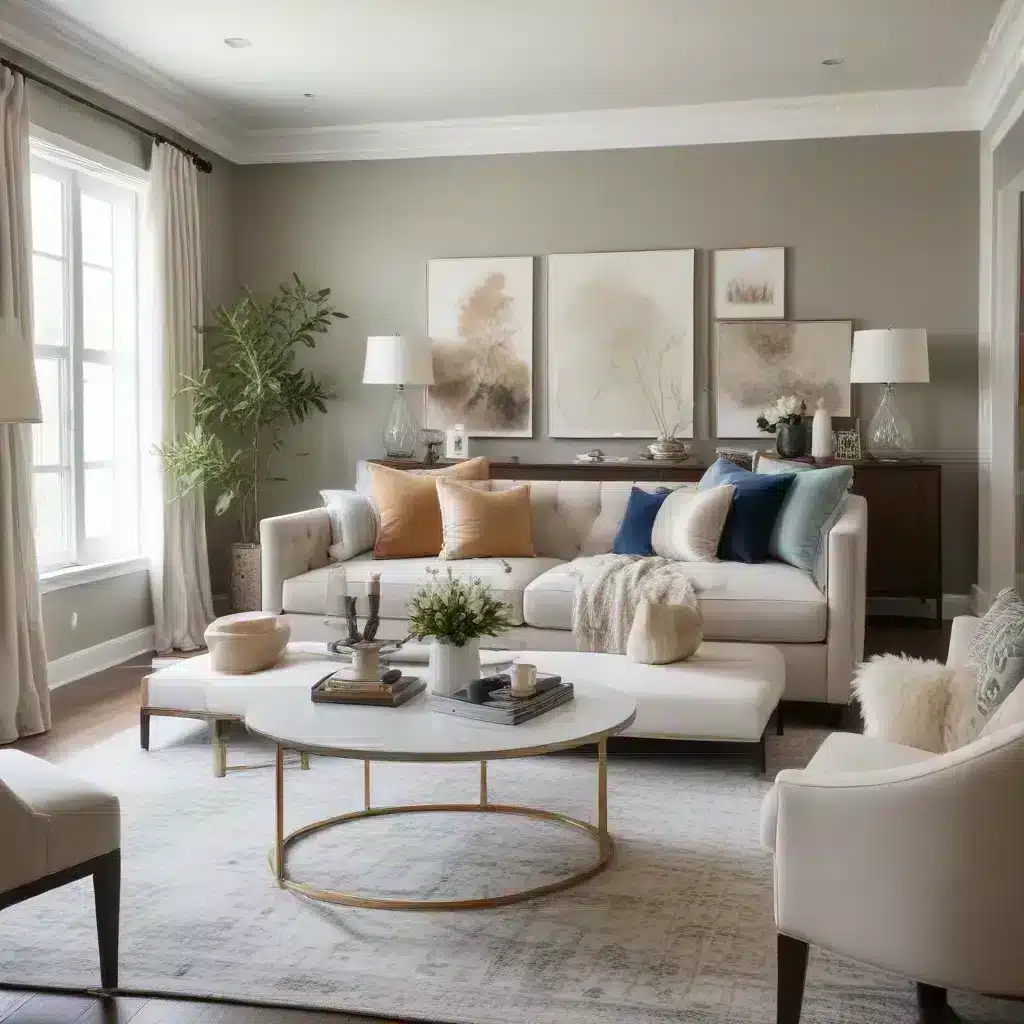
The Art of Sofa Selection
As a furniture specialist with years of experience, I’ve seen firsthand how a well-chosen sofa can transform a living space. It’s not just about comfort—though that’s certainly crucial—it’s about finding a piece that harmonizes with your overall design vision and lifestyle needs.
When I’m advising clients on sofa selection, I always start by asking them to consider the room’s purpose. Is it a formal living room for entertaining guests, or a cozy family room where movie nights and lazy Sundays reign supreme? The answer to this question will guide many of your choices, from the sofa’s style to its upholstery.
I remember working with a young couple who were furnishing their first home together. They were torn between a sleek, modern leather sofa and a plush, family-friendly sectional. After discussing their lifestyle—which included two large dogs and plans for children—we opted for the sectional in a durable, stain-resistant fabric. Years later, they told me it was the best decision they made for their home.
Upholstery Care: Keeping Your Sofa Looking Fresh
Once you’ve selected the perfect sofa, maintaining its appearance is key to ensuring it remains the centerpiece of your room for years to come. I’ve seen too many beautiful pieces fall victim to neglect, and it’s always a shame.
Here’s a tip I share with all my clients: invest in a good fabric protector. It’s like sunscreen for your sofa—a preventative measure that can save you a world of trouble down the line. I once had a client who spilled red wine on her brand new white linen sofa. Because we had applied a fabric protector, the wine beaded up and was easily blotted away with no staining.
Regular vacuuming is another must. It’s not just about keeping your sofa looking clean—it’s about preventing dust and debris from working their way into the fabric and breaking down the fibers. I recommend using the upholstery attachment on your vacuum cleaner at least once a week.
For leather sofas, I swear by a slightly damp microfiber cloth for regular cleaning. It’s gentle enough not to damage the leather but effective at removing dust and light stains. Just be sure to follow up with a dry cloth to prevent water marks.
Trends in Sofa Design: What’s Hot and What’s Timeless
In my years in the furniture industry, I’ve seen trends come and go. Remember when everyone wanted an overstuffed leather recliner in their living room? While comfort never goes out of style, the aesthetic preferences of homeowners are constantly evolving.
Currently, I’m seeing a strong trend towards sofas with clean lines and minimalist designs. Many of my clients are opting for sofas with exposed wooden legs and neutral-toned upholstery. This style works well in both modern and traditional settings, offering versatility that’s hard to beat.
Another trend I’m excited about is the return of curved sofas. These pieces add a softness to rooms that can sometimes feel boxy or angular. I recently helped a client select a beautiful curved sofa for their open-plan living area, and it instantly became the focal point of the space, drawing the eye and inviting conversation.
But remember, while it’s fun to embrace trends, it’s also important to consider longevity. A sofa is a significant investment, and you want it to stand the test of time both in terms of durability and style. That’s why I often recommend choosing a classic silhouette and then using throw pillows and blankets to incorporate trendier elements. This way, you can easily update your look without having to replace your entire sofa.
Space Planning: Making Your Sofa Work for Your Room
One of the most common mistakes I see in home design is poor space planning, particularly when it comes to sofas. A sofa that’s too large can overwhelm a room, while one that’s too small can make the space feel disjointed.
I always advise my clients to start by measuring their room and creating a floor plan. This doesn’t have to be anything fancy—a simple sketch with accurate measurements will do. Then, consider traffic flow. You want to ensure there’s enough space to walk comfortably around the sofa and any other furniture in the room.
Here’s a pro tip: use painter’s tape to mark out the dimensions of potential sofas on your floor. This gives you a real-sense of how much space the sofa will occupy and how it will interact with other elements in the room.
I once worked with a client who was convinced they needed a large L-shaped sectional for their living room. However, after mapping it out, we realized it would block access to their beautiful bay window. Instead, we opted for a loveseat and two armchairs, which created a cozy conversation area while still leaving the window accessible.
Remember, the goal is to create a space that’s both functional and aesthetically pleasing. Sometimes, this might mean thinking outside the box. For instance, in smaller spaces, consider a loveseat instead of a full-sized sofa, or even a pair of oversized armchairs that can be moved around as needed.
The Psychology of Color in Sofa Selection
Color plays a crucial role in interior design, and this is especially true when it comes to sofas. As the largest piece of furniture in most living rooms, your sofa’s color can set the tone for the entire space.
In my experience, neutral colors like beige, gray, and cream remain popular choices for sofas. They offer versatility and can easily be dressed up or down with accessories. However, don’t be afraid of color! A rich blue velvet sofa or a forest green leather piece can add depth and personality to a room.
I always encourage my clients to think about the mood they want to create in their space. Cool tones like blues and greens can create a calm, serene atmosphere, while warm tones like reds and oranges can energize a room.
One of my favorite projects involved helping a client choose a bold yellow sofa for their otherwise neutral living room. It was a daring choice, but it transformed the space, injecting it with energy and becoming a true conversation starter.
When selecting a color, also consider the practical aspects. Light colors show dirt more easily, which might not be ideal if you have pets or young children. Darker colors can make a room feel smaller, which might be a concern in compact spaces.
Remember, your sofa doesn’t exist in isolation. Consider how its color will interact with your walls, flooring, and other furniture pieces. The goal is to create a cohesive look that reflects your personal style.
Sustainability in Sofa Manufacturing: What to Look For
As awareness of environmental issues grows, I’ve noticed an increasing number of clients asking about sustainable options in furniture. This is a trend I’m thrilled to see, as it pushes manufacturers to adopt more eco-friendly practices.
When looking for a sustainable sofa, there are several factors to consider. First, look at the frame. Hardwood frames from sustainably managed forests are a good choice. Some manufacturers are even using recycled metal for sofa frames, which is an innovative approach to sustainability.
The upholstery is another important consideration. Natural fibers like organic cotton, hemp, and wool are renewable resources and often have a lower environmental impact than synthetic materials. However, some eco-friendly synthetic options are emerging, such as fabrics made from recycled plastic bottles.
I recently worked with a client who was passionate about sustainability. We found a beautiful sofa made with a frame of recycled steel, cushions filled with natural latex, and upholstery of organic cotton. Not only was it eco-friendly, but it was also incredibly comfortable and stylish.
Don’t forget to consider the manufacturing process as well. Look for companies that use low-VOC (Volatile Organic Compound) finishes and adhesives, as these release fewer harmful chemicals into the environment.
Lastly, durability is a key component of sustainability. A well-made sofa that lasts for decades is far more eco-friendly than a cheaply made one that needs to be replaced every few years. This is where investing in quality really pays off, both for your wallet and for the planet.
The Role of Texture in Sofa Design
While color often takes center stage in design discussions, I’ve found that texture can be equally important, especially when it comes to sofas. The tactile quality of your sofa not only affects its comfort but also contributes significantly to the overall feel of your space.
In my years of experience, I’ve noticed that mixing textures can add depth and interest to a room. For instance, pairing a smooth leather sofa with a fluffy shag rug creates a pleasing contrast that engages the senses.
I often advise clients to consider their lifestyle when choosing textures. For example, a family with young children might prefer a sofa with a tight, smooth weave that’s easy to clean, while a couple looking to create a luxurious retreat might opt for a plush velvet.
One of my favorite design tricks is using texture to create visual interest in a monochromatic color scheme. I once worked on a project where the client wanted an all-white living room. By incorporating a variety of textures—a leather sofa, a bouclé armchair, a shag rug, and woven throw pillows—we created a space that was visually dynamic despite the limited color palette.
Remember, texture isn’t just about how a sofa feels to the touch. It also affects how light interacts with the fabric, which can dramatically change the look of your sofa throughout the day. A glossy leather will reflect light differently than a matte linen, for instance.
When selecting your sofa, don’t just look at swatches—feel them. Run your hand over the fabric, sit on it if possible. The texture should feel pleasant to you, as you’ll be interacting with it daily.
Innovation in Sofa Technology: Comfort Meets Functionality
The world of sofa design is constantly evolving, and I’m always excited to see the latest innovations. Today’s sofas are not just seating options—they’re multifunctional pieces that adapt to our modern lifestyles.
One trend I’m seeing more of is the integration of technology into sofas. USB charging ports and wireless charging pads built into armrests or side tables are becoming increasingly common. For tech-savvy clients, these features can be a game-changer, eliminating the need for unsightly cords and ensuring devices are always within reach.
Another innovation I’m fond of is the development of “smart” fabrics. These materials are designed to be more durable, stain-resistant, and easier to clean than traditional upholstery fabrics. Some even incorporate temperature-regulating technology, ensuring your sofa remains comfortable year-round.
Modular sofas are also gaining popularity, especially among my clients with smaller living spaces or those who like to reconfigure their rooms frequently. These pieces can be rearranged to suit different needs—from a large sectional for movie night to individual seats for a cocktail party.
I recently worked with a client who had a small apartment but loved to entertain. We chose a modular sofa that could be configured as a traditional three-seater or separated into individual chairs. This flexibility allowed them to maximize their limited space without sacrificing style or comfort.
Storage solutions are another area where I’m seeing exciting developments. Sofas with built-in storage compartments in the base or arms are perfect for those looking to maximize space efficiency. I’ve even seen designs with integrated side tables or bookshelves, truly making the sofa a multifunctional centerpiece of the room.
While these innovations are exciting, I always remind my clients that the core purpose of a sofa—providing comfortable seating—should never be compromised. No amount of tech features can make up for a sofa that’s uncomfortable to sit on.
The Impact of Lighting on Your Sofa’s Appearance
One aspect of sofa selection that’s often overlooked is how lighting can affect its appearance. In my years as a furniture specialist, I’ve seen countless instances where a sofa that looked perfect in the showroom seemed completely different once it was in the client’s home.
Natural light plays a significant role in how we perceive color and texture. A sofa that looks warm and inviting in soft morning light might appear washed out in the harsh afternoon sun. That’s why I always recommend my clients consider the lighting conditions in their space when choosing a sofa.
If your room gets a lot of natural light, you might want to opt for fabrics that are less likely to fade, such as synthetic blends or treated natural fibers. Conversely, if your space lacks natural light, lighter colored sofas can help brighten the room and make it feel more spacious.
Artificial lighting is equally important. The type of bulbs you use can dramatically alter the appearance of your sofa. LED lights, for instance, can make cool tones appear more vibrant, while incandescent bulbs tend to warm up colors.
I once worked with a client who fell in love with a deep blue velvet sofa in our showroom. However, when we delivered it to their home, which was lit primarily with warm-toned lamps, the sofa appeared almost purple. We solved this by changing their lighting to cooler-toned bulbs, which brought out the true blue of the fabric.
Don’t forget about the interplay between your sofa and nearby light sources. A floor lamp positioned near your sofa can create interesting shadows and highlights, adding depth to the texture of the fabric.
When selecting a sofa, try to view it under lighting conditions similar to those in your home. If possible, ask for fabric samples that you can take home and see in your space at different times of day. This extra step can save you from disappointment down the line.
The Art of Accessorizing Your Sofa
Once you’ve selected the perfect sofa, the next step is to accessorize it. This is where you can really let your personality shine and tie your sofa into the overall design of your room.
Throw pillows are perhaps the most versatile sofa accessory. They offer an easy way to introduce color, pattern, and texture to your seating area. I always advise my clients to mix and match pillows of different sizes and shapes for a more dynamic look.
When it comes to throw pillows, don’t be afraid to experiment. I once worked with a client who had a neutral gray sofa. We added vibrancy to the space with a combination of solid-colored velvet pillows and others with bold geometric patterns. The result was a sofa that went from bland to a true focal point of the room.
Throws are another great accessory. Not only do they add visual interest, but they also serve a practical purpose, providing warmth on chilly evenings. I love using throws to introduce texture—a chunky knit throw can add a cozy feel to a sleek leather sofa, for instance.
Consider the space behind your sofa as well. A console table placed behind a floating sofa can create a finished look and provide a surface for lamps, books, or decorative objects. If your sofa is against a wall, a large piece of artwork or a gallery wall can serve as a beautiful backdrop.
Remember, accessorizing is an ongoing process. Feel free to switch things up seasonally or as your tastes change. This is a great way to keep your living space feeling fresh and current without the need for major renovations.
In my experience, the key to successful accessorizing is balance. You want to enhance your sofa, not overwhelm it. Start with a few key pieces and build from there, stepping back regularly to assess the overall effect.
Sofa Placement: Creating Flow in Your Living Space
The placement of your sofa can make or break the flow of your living space. Over the years, I’ve learned that there’s much more to consider than simply pushing the sofa against a wall.
First, consider the focal point of your room. This could be a fireplace, a large window with a view, or even a TV. Generally, you’ll want to orient your sofa towards this focal point. However, don’t be afraid to angle your sofa if it creates a more inviting arrangement or improves traffic flow.
In open-plan living areas, sofas can be used to define spaces. I once worked with a client who had a large, open-concept living and dining area. By placing the sofa perpendicular to the dining table, we were able to create distinct zones within the space without disrupting the open feel.
Consider the other furniture in your room as well. You want to create conversation areas where people can comfortably interact. A good rule of thumb is to keep seating pieces no more than 8 feet apart to facilitate easy conversation.
Don’t forget about negative space. While it might be tempting to fill every corner, leaving some open space can make a room feel larger and more relaxing. I always remind my clients that sometimes, less is more.
If you have a large room, consider creating multiple seating areas. This can make the space feel more intimate and provide options for different activities. For example, you might have a main seating area centered around the TV, and a smaller, quieter nook for reading or intimate conversations.
Remember, there’s no one-size-fits-all solution when it comes to sofa placement. It’s about finding what works best for your space and lifestyle. Don’t be afraid to experiment with different arrangements until you find the one that feels right.
In conclusion, choosing and styling a sofa is both an art and a science. It requires careful consideration of factors like size, color, texture, and placement. But with thoughtful planning and a bit of creativity, your sofa can become the perfect centerpiece for your living space, reflecting your personal style and meeting your practical needs.
For more expert advice on creating your dream living space, visit Sofa Spectacular. Our team of furniture specialists is always ready to help you find the perfect pieces to bring your vision to life.




